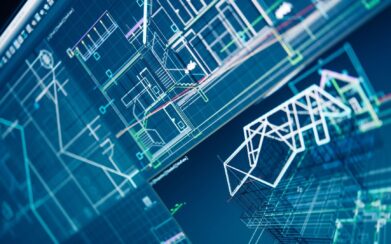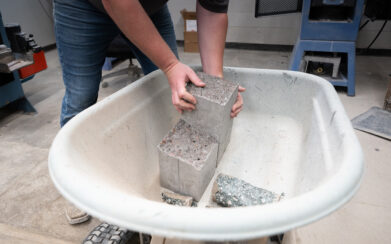Insights
Cross-Discipline Collaboration From a VDC Perspective
Cross-discipline coordination has been essential to the architecture, engineering, and construction (AEC) industry for years. This practice aids in collaboration, can potentially reduce errors, and could improve project outcomes as multiple disciplines are working together to make sure design elements are seamlessly integrated.
For PEC’s Virtual Design and Construction (VDC) team, it is an important part of the process. With the introduction of Building Information Modeling (BIM) and other advanced 3D design tools to the architecture and engineering industry, project teams gain the ability to collaborate and coordinate their efforts in real-time with live modeling. By leveraging these tools, teams can identify and resolve conflicts early, enhance communication, and streamline workflows. This can lead to higher-quality outcomes and reduce the risk of costly rework and delays.
Through cross-discipline coordination, architects and engineers can streamline their project delivery processes, drive innovation, and achieve better results in their projects.
What is Cross-Discipline Coordination?

Cross-discipline coordination involves the seamless integration of various disciplines within an industry. This approach allows all stakeholders to share information and align their efforts to achieve common project goals.
The AEC industry has traditionally faced challenges related to fragmented workflows, miscommunication, and design conflicts. These issues often lead to project delays, cost overruns, and compromised quality. However, cross-discipline coordination has helped overcome these issues and has offered significant improvements in project delivery and outcomes.
Benefits of Cross-Discipline Coordination
- Collaboration: Facilitates real-time communication and collaboration among architects, engineers, and other stakeholders. By using integrated platforms and tools, teams can share updates, review designs, and address issues more readily which leads to a more cohesive project execution. Collaboration can foster a sense of teamwork and shared responsibility; this is crucial for the success of complex projects.
- Clash Detection and Resolution: Identifies and resolves design conflicts early in the project lifecycle. Advanced BIM tools enable the detection of clashes between different disciplines’ models. This allows teams to address these issues before construction begins thus possibly avoiding costly rework and delays. Early clash detection also helps in maintaining the integrity of the design and can help all components fit together seamlessly.
- Improved Accuracy: This renders more thoughtful and detailed designs while reducing the likelihood of errors and rework. As design intent is maintained throughout the project, accurate models and coordinated efforts lead to higher-quality outcomes. Improved accuracy also enhances the overall efficiency of the construction process as fewer changes are needed during the execution phase.
- Cost and Time Savings: Minimizes construction delays and cost overruns by optimizing design processes and workflows which include cross-discipline coordination. Coordination reduces the potential of errors, rework, and miscommunication. Cost and time savings are particularly important in large-scale projects where even minor delays could have significant financial implications.
Best Practices for Cross-Discipline Coordination
- Develop a BIM Execution Plan (BxP): Establish clear guidelines for BIM implementation, including roles, responsibilities, and data-sharing protocols. A well-defined BxP communicates expectations to all team members their tasks and the project’s BIM requirements while fostering a collaborative environment. The BxP should outline the project’s objectives, the level of detail required for each model, and the procedures for data exchange and model updates.
- Use a Common Data Environment (CDE): Centralize project data to help all stakeholders have access to the latest information. A CDE serves as a single source of truth and is where all project data is stored, managed, and shared. This aids in the reduction of miscommunication or designing within a silo. Some companies use Autodesk Construction Cloud as their CDE. This platform supports version control, access management, and real-time collaboration helping all team members work with the most up-to-date information.
- Regular Clash Detection: Conduct frequent model checks to identify and resolve conflicts early. Regular clash detection sessions help teams address issues proactively and prevent them from escalating into larger problems during construction. These sessions should be scheduled for key project milestones and should involve representatives from all disciplines for a comprehensive review and resolution of clashes.
- Standardize Workflows: Implement industry- standard BIM protocols to streamline processes and improve efficiency. Standardized workflows foster consistency across the project and facilitate a more streamlined method for team members to collaborate and share information. Standardized workflows foster consistency across the project and facilitate a more streamlined method for team members to collaborate and share information. Standardization also helps in maintaining quality and reducing the learning curve for new team members as they can quickly adapt to established procedures.
- Continuous Training and Development: Invest in training programs to keep team members updated on the latest tools and techniques. Ongoing education helps the team remain proficient in using advanced BIM tools and stay abreast of industry best practices. Training programs should cover both technical skills and soft skills (such as communication and collaboration) to enhance overall team performance.
Tools for Cross-Discipline Coordination
- Autodesk BIM Collaborate: A comprehensive platform for model coordination, clash detection, and issue management. BIM Collaborate enables teams to work together in a cloud-based environment while facilitating real-time collaboration and streamlined workflows. The platform supports model aggregation, clash detection, and issue tracking; this makes it easier for teams to coordinate their efforts and resolve conflicts.
- Navisworks: A powerful tool for 3D model review, clash detection, and project coordination. Navisworks allows teams to aggregate models from different disciplines, perform clash detection, and visualize the project in a unified environment. The tool also supports 4D simulation which enables teams to plan and manage construction schedules more effectively.
- Revit: Widely used for architectural and engineering design and offers robust BIM capabilities. Revit supports multidiscipline design and offers robust BIM capabilities. Revit supports multidiscipline design and documentation which allows architects and engineers to work within a single platform and more easily maintain a coordinated model. The tool also supports parametric modeling where teams can make changes to the design quickly and efficiently.
A Connected Future
Cross-discipline coordination for modern AEC projects looks differently today than it did many years ago, but offers the same benefits in terms of collaboration, accuracy, and efficiently. By adopting best practices and leveraging advanced tools, architects and engineers can achieve better project outcomes and drive innovation in the industry. Effective cross-discipline coordination can improve project delivery and enhance the overall quality of the built environment.
The integration of BIM tools and collaborative platforms can transform the way AEC professionals work together and assist them to overcome challenges and strive to achieve greater success. As industry continues to evolve, the importance of cross-discipline coordination will only grow as a helpful component of future project delivery.











